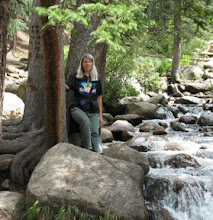
Here in the dark of winter, will a few more alpine wildflowers brighten your day? I'd like to share a few of those specially adapted plants that live nowhere else—unless it's in the arctic tundra, where conditions, at least of temperature, are somewhat similar. It's winter down here too, but on the tundra it's winter with a vengeance!
Today on the tundra (or as close as I can get weather info), it's 6 degrees F (-14 C), but a 12 mph wind ( kph) makes it feel more like -9 F (-23 C). Factor in a few thousand extra feet (1,000 m) of elevation, and it's going to be much colder than that! Probably a good bit more windy as well. Not until the end of May will temperatures again reach above freezing, and they will do so only for about 45 days.
Today the plants known as cushion plants are demonstrating what they're built for—hugging the ground, hiding from the wind, or at least exposing as little area as possible. Each cushion may be perhaps 6 inches (15 cm) wide and hundreds of years old. Each has a substantial taproot anchoring it to what soil there is and extending far down among the rocks. But their above-ground parts rarely reach more than an inch or two (2-5 cm) into the air.
 This little Alpine Primrose (Primula angustifolia) is not a cushion plant. But note the tiny leaves forming a background for its larger glossy green leaves. Those leaves are part of a very common cushion plant, the Moss Campion or Moss Pink (Silene acaulis). Its leaves are indeed very like those of mosses. It's the 5th of July, and this cushion is already well past flowering. We'd already missed the profusion of tiny pink flowers of the campion, as well as its fellow cushions, white-flowered alpine Phlox pulvinata and the tiny yellowish flowers of Alpine Nailwort, Paronychia pulvinata. Distracted by showier flowers, I failed to distinguish their matted leaves.
This little Alpine Primrose (Primula angustifolia) is not a cushion plant. But note the tiny leaves forming a background for its larger glossy green leaves. Those leaves are part of a very common cushion plant, the Moss Campion or Moss Pink (Silene acaulis). Its leaves are indeed very like those of mosses. It's the 5th of July, and this cushion is already well past flowering. We'd already missed the profusion of tiny pink flowers of the campion, as well as its fellow cushions, white-flowered alpine Phlox pulvinata and the tiny yellowish flowers of Alpine Nailwort, Paronychia pulvinata. Distracted by showier flowers, I failed to distinguish their matted leaves.There's a story in the photo above, an example of those occasions when a scientific paper shares an insight that can revolutionize the way we look at things. Why is the primrose (and if you enlarge the photo above, several other plants) growing in the middle of the cushion of Moss Campion? Fernlike leaves to the right of our Primula, and grasslike leaves on the left, suggest that cushion plants can be nurseries for the seeds of other tundra species. This phenomenon, documented by Robert Griggs in 1956, is another small example of the opportunism plants, especially seeds, regularly display. What more secure place for a tiny seed than tucked down amid the leaves of an established cushion?
Alas, science proceeds by a series of successive approximations. A later approximation reported that the seeds (and resulting seedlings) are not as safe and cozy as we might think. In fact, mortality of new seedlings in cushions is just slightly higher than it is for those growing out in the open. Perhaps we'll await the next approximation, in hopes Griggs's original story is confirmed one day.
Refs: Griggs, R.F. 1956. Ecology 37:8-20.
Bonde, E.K. 1968. Ecology 49:1194-95.

No comments:
Post a Comment